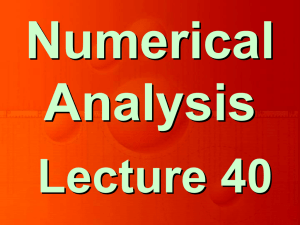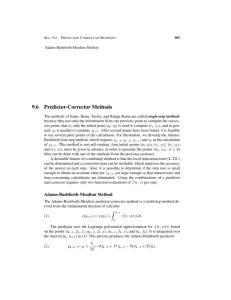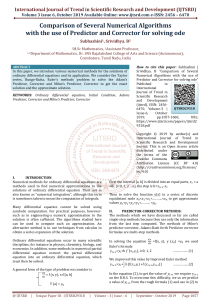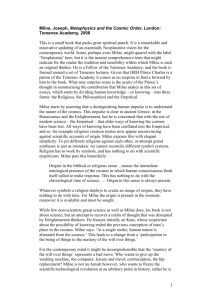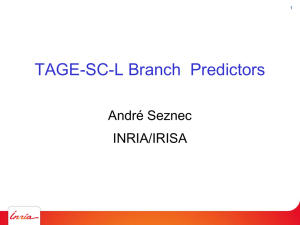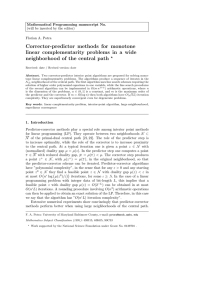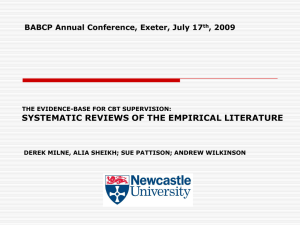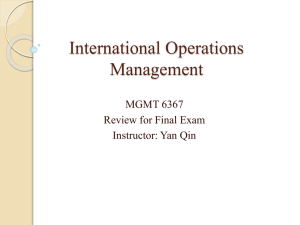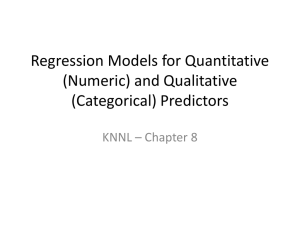Click to add title
advertisement
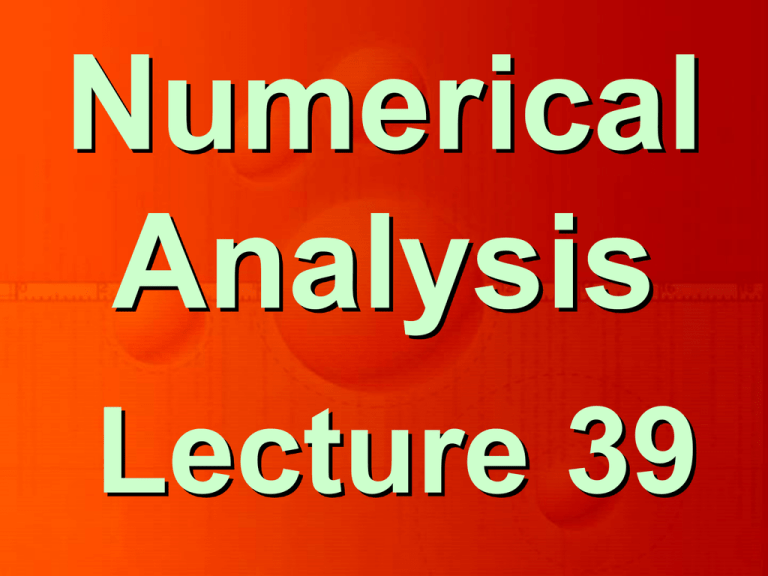
Numerical
Analysis
Lecture 39
Chapter 7
Ordinary
Differential
Equations
Introduction
Taylor Series
Euler Method
Runge-Kutta Method
Predictor Corrector
Method
PREDICTOR –
CORRECTOR
METHOD
The methods presented so
far are called single-step
methods, where we have
seen that the computation of
y at tn+1 that is yn+1 requires
the knowledge of yn only.
In predictor-corrector
methods which we will
discuss now, is also known
as multi-step methods.
To compute the value of y at
tn+1, we must know the
solution y at tn, tn-1, tn-2, etc.
Thus, a predictor formula is
used to predict the value of y at
tn+1 and then a corrector
formula is used to improve the
value of yn+1.
Let us consider an IVP
dy
f (t , y ),
dt
y (tn ) yn
Using simple Euler’s and
modified Euler’s method, we
can write down a simple
predictor-corrector pair
(P – C) as
h
(1)
(0)
C : yn1 yn f (tn , yn ) f (tn 1 , yn 1 )
2
(0)
n 1
P: y
yn hf (tn , yn )
(1)
Here, yn+1 is the first corrected
value of yn+1. The corrector
formula may be used iteratively
as defined below:
y
(r )
n 1
h
yn f (tn , yn ) f (tn 1 , yn( r11) ) ,
2
r 1, 2,
The iteration is terminated
when two successive iterates
agree to the desired accuracy
In this pair, to extrapolate
the value of yn+1, we have
approximated the solution
curve in the interval (tn, tn+1)
by a straight line passing
through (tn, yn) and
(tn+1, yn+1).
The accuracy of the
predictor formula can be
improved by considering a
quadratic curve through the
equally spaced points
(tn-1, yn-1), (tn, yn), (tn+1, yn+1)
Suppose we fit a quadratic
curve of the form
y a b(t tn1 ) c(t tn )(t tn1 )
where a, b, c are constants
to be determined
As the curve passes through
(tn-1, yn-1) and (tn, yn) and
satisfies dy
f (tn , yn )
dt (tn , yn )
we obtain
yn1 a,
yn a bh yn1 bh
Therefore
yn yn 1
b
h
and
dy
f (tn , yn ) {b c[(t tn1 ) (t tn )]}(tn , yn )
dt (tn , yn )
Which gives
f (tn , yn ) b c(tn tn1 ) b ch
or
f (tn , yn ) ( yn yn 1 )
c
2
h
h
Substituting these values of
a, b and c into the quadratic
equation, we get
yn1 yn1 2( yn yn1 ) 2[hf (tn , yn ) ( yn yn1 )]
That is,
yn1 yn1 2hf (tn , yn )
Thus, instead of considering
the P-C pair, we may consider
the P-C pair given by
P : yn1 yn 1 2hf (tn , yn )
h
C : yn1 yn [ f (tn , yn ) f (tn1 , yn1 )]
2
The essential difference
between them is, the one
given above is more accurate
However, this one can not
be used to predict yn+1 for a
given IVP, because its use
require the knowledge of
past two points. In such a
situation, a R-K method is
generally used to start the
predictor method.
Milne’s Method
It is also a multi-step
method where we assume
that the solution to the given
IVP is known at the past four
equally spaced point t0, t1, t2
and t3.
To derive Milne’s predictorcorrector pair, let us consider
a typical IVP
dy
f (t , y ),
dt
y (t0 ) y0
On integration between the
limits t0 and t4, we get
t4
t0
t4
dy
dt f (t , y )dt
t
0
dt
t4
y4 y0 f (t , y)dt
t0
But we know from Newton’s
forward difference formula
s( s 1) 2
s ( s 1)( s 2) 3
f (t , y ) f 0 sf 0
f0
f0
2
6
where
y4 y0
t4
t0
t t0
s
,
h
t t0 sh
s( s 1) 2
s( s 1)( s 2) 3
f0
f 0 sf 0 2 f 0
6
s( s 1( s 2)( s 3) 4
f 0 dt
24
Now, by changing the
variable of integration (from t
to s), the limits of integration
also changes (from 0 to 4),
and thus the above
expression becomes
y4 y0 h
4
0
s( s 1) 2
s( s 1)( s 2) 3
f0
4 f 0 sf 0 2 f 0
6
s( s 1( s 2)( s 3) 4
f 0 ds
24
which simplifies to
20 2
8 3
28 4
y4 y0 h 4 f 0 8f 0 f 0 f 0 f 0
3
3
90
Substituting the differences
f0 f1 f0 , 2 f0 f2 2 f1 f0 ,
It can be further simplified to
4h
28 4
y4 y0 (2 f1 f 2 2 f3 ) h f 0
3
90
Alternatively, it can also be
written as
4h
28 4
y4 y0
(2 y1 y2 2 y3 ) h y0
3
90
This is known as Milne’s
predictor formula.
Similarly, integrating the
original over the interval t0 to
t2 or s = 0 to 2 and repeating
the above steps, we get
h
1
4
y2 y0 ( y0 4 y1 y2 ) h y0
3
90
which is known as Milne’s
corrector formula.
In general, Milne’s predictorcorrector pair can be written
as
4h
P : yn 1 yn 3 (2 yn 2 yn 1 2 yn )
3
h
C : yn 1 yn 1 ( yn 1 4 yn yn 1 )
3
From these equations, we
observe that the magnitude of
the truncation error in
corrector formula is (1/ 90)h y ,
while the truncation error in
predictor formula is (28/ 90) y .
4
0
4
0
Thus: TE in, c-formula is less
than the TE in p-formula.
In order to apply this P – C
method to solve numerically
any initial value problem, we
first predict the value of yn+1
by means of predictor
formula, where derivatives
are computed using the given
differential equation itself.
Using the predicted value
yn+1, we calculate the
derivative y’n+1 from the given
differential equation and then
we use the corrector formula
of the pair to have the
corrected value of yn+1
This in turn may be used to
obtain improved value of
yn+1 by using corrector
again. This in turn may be
used to obtain improved
value of yn+1 by using the
corrector again. This cycle
is repeated until we achieve
the required accuracy.
Example
Find y (2.0) if y ( t ) is the
solution of dy 1 (t y )
dt
2
y (0) = 2, y (0.5) = 2.636,
y (1.0) = 3.595 and y(1.5) = 4.968
Use Milne’s P-C method.
Solution
Taking t0 = 0.0, t1 = 0.5,
t2 = 1.0, t3 = 1.5
y0, y1, y2 and y3, are given, we
have to compute y4, the
solution of the given
differential equation
corresponding to t =2.0
The Milne’s P – C pair is
given as
4h
P : yn 1 yn 3 (2 yn 2 yn 1 2 yn )
3
h
C : yn 1 yn 1 ( yn 1 4 yn yn 1 )
3
From the given differential
equation, y (t y ) / 2.
We have,
t1 y1 0.5 2.636
y1
1.5680
2
2
t2 y2 1.0 3.595
y2
2.2975
2
2
t3 y3 1.5 4.968
y3
3.2340
2
2
Now, using predictor
formula, we compute
4h
y4 y0 (2 y1 y2 2 y3 )
3
4(0.5)
2
2(1.5680) 2.2975 2(3.2340)
3
6.8710
Using this predicted value,
we shall compute the
improved value of y4 from
corrector formula
h
y4 y2 ( y2 4 y3 y4 )
3
Using the available predicted
value y4 and the initial
values, we compute
t4 y4 2 6.68710
y4
4.4355
2
2
t3 y3 1.5 4.968
y3
3.2340
2
2
and
y2 2.2975
Thus, the first corrected
value of y4 is given by
(1)
4
y
0.5
3.595
[2.2975 4(3.234) 4.4355]
3
6.8731667
Suppose, we apply the
corrector formula again, then
we have
h
y y2 ( y2 4 y3 ( y4(1) )
3
0.5
2 6.8731667
3.595
2.2975 4(3.234)
3
2
6.8733467
(2)
4
Finally, y (2.0) = y4 = 6.8734.
Example
Tabulate the solution of
dy
t y,
dt
y (0) 1
in the interval [0, 0.4] with
h = 0.1, using Milne’s P-C
method.
Solution
Milne’s P-C method demand
the solution at first four points
t0, t1, t2 and t3. As it is not a
self – starting method, we
shall use R-K method of fourth
order to get the required
solution and then switch over
to Milne’s P – C method.
Thus, taking t0 = 0, t1 = 0.1,
t2 = 0.2, t3 = 0.3 we get the
corresponding y values using
R–K method of 4th order;
that is y0 = 1, y1 = 1.1103,
y2 = 1.2428 and y3 = 1.3997
(Reference Lecture 38)
Now, we compute
y1 t1 y1 0.1 1.1103 1.2103
y2 t2 y2 0.2 1.2428 1.4428
y3 t3 y3 0.3 1.3997 1.6997
Using Milne’s predictor
formula
4h
P : y4 y0 (2 y1 y2 2 y3 )
3
4(0.5)
1
2(1.21103) 1.4428 2(1.69971)
3
1.58363
Before using corrector
formula, we compute
y4 t4 y4 ( predicted value)
0.4 1.5836 1.9836
Finally, using Milne’s corrector
formula, we compute
h
C : y4 y2 ( y4 4 y3 y2 )
3
0.1
1.2428
(1.9836 6.7988 1.4428)
3
1.5836
The required solution is:
t
0
0.1
0.2
0.3
0.4
y
1
1.1103 1.2428 1.3997 1.5836
Numerical
Analysis
Lecture 39
